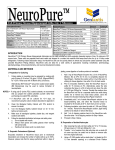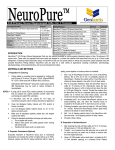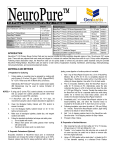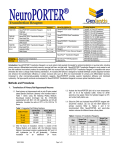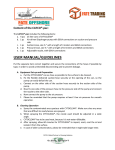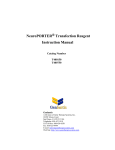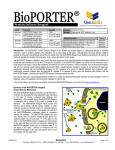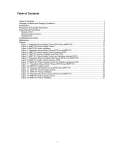Download Neuronal Transfection Reagent
Transcript
Neuronal Transfection Reagent Contents A division of Gene Therapy Systems, Inc. Related Products (Continued) Catalog # Content Amount Catalog # Content Amount T800075 NeuroFECT Transfection Reagent, 75 - 300 rxns 0.75 ml N300200 NeuroPure™ P8 Rat Cerebellar Cells 4 x107 cells T800750 NeuroFECT Transfection Reagent, 375 - 1500 rxns 5 x 0.75 ml N400200 NeuroPure™ E18 Primary Rat Hypothalamus 1 pair N500200 NeuroPure™ E18 Primary Rat Striata 1 pair N600200 NeuroPure™ E18 Primary Rat Spinal Cord 1 spinal cord 1 midbrain Related Products Catalog # Content Amount N700200 NeuroPure™ E18 Primary Rat Midbrain N100200 NeuroPure™ E18 Primary Rat Hippocampal Cells 1 x 106 cells N100300 NeuroStem™ E18 Rat Hippocampal Progenitors 1 x 106 cells N200200 NeuroPure™ E18 Primary Rat Cortical Cells 2 x 106 cells N200300 NeuroPure™ E18 Rat Cortical Progenitors Shipping and Storage: 2 x 106 cells NeuroFECT Transfection Reagent is shipped at room temperature. For maximum stability, store all reagents at 4°C upon receipt. When stored properly, the NeuroFECT reagent is stable for 6 months. INTRODUCTION: NeuroFect™ is a novel biodegradable cationic polymer created specifically for optimal transfection of neuronal cells. During transfection, the polymer/DNA complexes (polyplexes) are endocytosed into the cells, where the polymer is biodegraded into small non-toxic molecules. The ability of NeuroFect to biodegrade in vivo dramatically reduces its cytotoxicity and therefore maximizes the delivery of macromolecules into cells. NeuroFect is compatible with serum containing media, is easy to use, and provides the highest possible transfection efficiencies for your primary neurons. MATERIALS AND METHODS A. Preliminary Notes I. The NeuroFECT Reagent is provided at a stock concentration of 5 µg/µl. You may use the reagent at the stock concentration or dilute it to 1 µg/µl for easier pipetting and transfection optimization. Use only sterile water or serum-free medium (such as OptiMem® I Medium, Invitrogen Corporation, Cat. # 31985-070) for dilution. If diluting with serum-free medium, NeuroFECT should be used within 30 minutes. II. The following protocol was derived from optimizing transfection of Primary E18 Rat Hippocampal Neurons (Cat. # N100200) and Primary E18 Rat Cortical Neurons (Cat. # N200200). The DNA amounts, NeuroFECT:DNA ratios, cell plating densities, and timing of transfection may vary for other types of primary neurons and neuronal cell lines. However, the values given below for these parameters should function as good starting points. Optimization guidelines are provided on Page 2. B. Preparation and Growth of Primary Neurons 1. Seed neurons on freshly coated poly-lysine coated plates in the densities indicated in Table 1 using the following media for primary neurons: Neurobasal/B27, 0.5 mM glutamine (Add 0.25 µM glutamate for hippocampal neurons). 2. Incubate the cells at 37 ºC in 5% CO2 for 3 days. 3. After 3 days, remove half of the plating medium volume per well and replace with same amount of the primary neuronal culture medium indicated in step 1 above. (Do not use glutamate at this point for hippocampal neurons.) Table 1: Cell Densities and Media Volume per Well Primary Neuron Type 24-well Plate 96-Well Plate Cortical Neurons 80,000 cells/well 20,000 cells/well Hippocampal Neurons 65,000 cells/well 15,000 cells/well Media Volume 100 µl/well 500 µl/well 4. Continue culturing the cells for an additional 3-4 days Version MV090106 Genlantis Phone: 858-457-1919 y 888-428-0558 (U.S. Toll-free) y Fax: 858-623-9494 www.genlantis.com Page 1 of 2 C. Transfection 5. Prepare the NeuroFECT and DNA in separate tubes according to Table 2. Dilute the NeuroFECT in half the Serum-Free Medium (SFM) volume indicated in Table 2 and your DNA in the other half of SFM, e.g., for Primary Hippocampal Neurons in 24-well plates, dilute 4 µg of NeuroFECT in 50 µl of SFM and 1.0 µg in 50 µl of SFM. Table 2: NeuroFECT, DNA, and SFM Amounts for Complex Formation in Primary Rat Hippocampal and Cortical Neurons 24-well plates (amounts per well) 96-well plates (amounts per well) Reagent Amounts Reagent Amounts Neuron Type NeuroFECT DNA SFM* NeuroFECT DNA SFM* Primary Hippocampal Neurons 4 µg 1.0 µg 100 µl 1.5 µg 0.25 µg 50 µl Primary Cortical Neurons 5 µg 1.0 µg 100 µl 1.75 µg 0.25 µg 50 µl *SFM = Serum-Free Medium (Dilute the NeuroFect amount inidcated in half this volume and the DNA amount in the other half of this volume) 6. For NeuroFECT/DNA Complex Formation, add the reagents in this order: diluted NeuroFECT to diluted DNA in a drop wise fashion, and mix with gentle pipetting. 7. Incubate the NeuroFECT/DNA complex for 15-20 minutes at room temperature. 8. Remove half the old culture medium from the cells and replace with half the volume of fresh culture medium indicated in Table 1. 9. Add the NeuroFECT/DNA complexes to the cells. Gently mix by swirling plate. 10. Incubate the cells at 37 ºC in 5% CO2. 11. Perform gene expression assay 24-48 hours later. D. Transfection Optimization Guidelines 12. To obtain the maximum transfection efficiency for other cell types besides primary cortical and hippocampal neurons, and for other tissue culture dish sizes besides 24-well and 96-well plates, we recommend using the above-mentioned DNA quantities and NeuroFECT/DNA ratios as starting points, and then testing different conditions according to the following guidelines: Table 3: Transfection Optimization Guidelines DNA SFM* Media Volume‡ 0.1 – 0.5 µg 50 ul 100 µl 0.5 – 2 µg 100 ul 500 µl 2 – 6 µg 500 ul 1 ml 60 mm 6 – 8 µg 1 ml 2.5 ml 100 mm 8 – 12 µg 2 ml 5 ml Tissue Culture Dish NeuroFECT: DNA Ratio 96-well 24-well 4:1 – 8:1 (µg:µg) 6-well *SFM = Serum-Free Medium (Dilute the NeuroFect amount inidcated in half this volume and the DNA amount in the other half of this volume) ‡ Volume prior to adding NeuroFECT/DNA Complexes 13. Optimization of cell plating densities for transfection of primary cells should start using densities giving maximum cell health during routine culturing. Greater or lessor densities can then be tested. Optimization of plating densities for transfection of neuronal cell lines should start at those giving 50-70% confluency on the day of transfection. 14. For addressing any cytotoxicity that may occur, it is recommended to reduce the amount of NeuroFECT reagent used in 15% increments until the cytotoxicity is eliminated. License The purchase price paid for the NeuroFect™ Transfection Reagent Kit grants end users a non-transferable, non-exclusive license to use the kit and/or its components for internal research use only as described in this manual; in particular, research use only excludes and without limitation, resale, repackaging, or use for the making or selling of any commercial product or service without the written approval of Genlantis. Separate licenses are available for non-research use or applications. The NeuroFect Transfection Reagent Kit is not to be used for human diagnostic or included/used in any drug intended for human use. Care and attention should be exercised in handling the kit components by following appropriate research lab practices. Purchasers may refuse this license by returning the enclosed materials unused. By keeping or using the enclosed materials, you agree to be bound by the terms of this license. The laws of the State of California shall govern the interpretation and enforcement of the terms of this Licence. Version MV090106 Genlantis Phone: 858-457-1919 y 888-428-0558 (U.S. Toll-free) y Fax: 858-623-9494 www.genlantis.com Page 2 of 2




